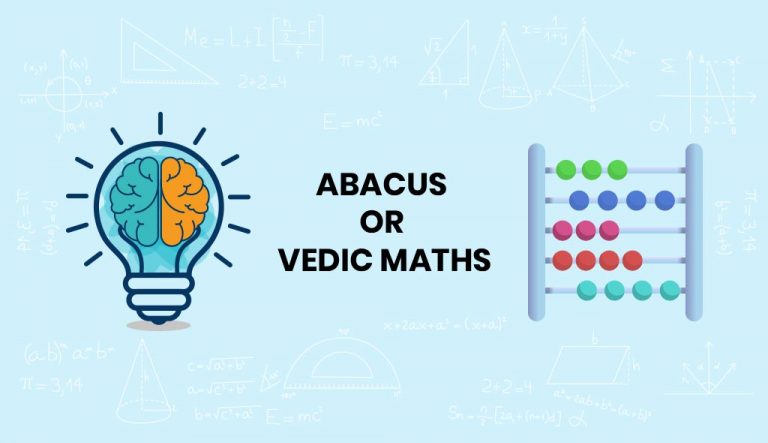Parenting(Age 5 to 8) | Academic | General | Parenting(Age 9 to 12) | Parenting(Age 13 to 16) | 2 year AGO
Introduction to Abacus Math and Vedic Math

Mathematics is a topic that most of us find tough. Calculations and number games are inseparable aspects of our daily life. Solving issues using standard mathematical processes can be difficult and time-consuming at times. For school children to conquer math, two alternative ancient approaches are now available. Students may accomplish huge and complicated calculations in their heads using one of these techniques without the use of any current technology.
The first technique is Abacus. Learning this makes mathematical calculation simple and fun. It is essential to introduce abacus at an appropriate age so that the child can practice and gain mastery. A regular abacus can be used for addition, subtraction, division, and multiplication, as well as extracting square roots and cubic roots. The index finger or thumb of the hand is used to manage the beads and get the desired results.
The second technique is Vedic Mathematics. It is a set of techniques/sutras for quickly and easily solving mathematical problems. It is made up of 16 Sutras which are known as formulae and 13 Sub-Sutras that are sub-formulas, that can be applied to a variety of issues in arithmetic, algebra, geometry, calculus, and conics.
The Birth of these techniques
The abacus is an instrument that traces back to the Greek and Roman eras. As abacus moved over the world, it has evolved into different sorts. However, it was in China that the abacus was further developed and broadly applied in everyday calculations. Abacus math is a technique adapted from an ancient technology that works well today. The usage of an abacus can boost one's confidence, give them a sense of accomplishment, increase intuitive thinking, increase problem-solving skills, encourage creativity, and improve focus and mental stamina.
For Vedic Mathematics, there is no legal definition. Hindu philosophy is based on the Vedas, and Vedic Math is derived from these scriptures. Sri Bharati Krsna Tirthaji found these old texts and translated the complicated material into more easily understandable mathematics. The system is based on 16 Vedic sutras, which are word formulas that describe natural solutions to a variety of mathematical problems. These 16 one-line formulae, which were originally written in Sanskrit and are easy to recall, allow you to solve long mathematical problems swiftly. These formulae reflect how the mind functions in its natural state and are thus beneficial in guiding the student to the most appropriate technique of solution.
The Difference Between the Two Techniques
Abacus math emphasizes the use of an abacus as a method for learning math. To indicate the number, beads are moved up and down across several columns. When kids move the abacus beads with both hands to perform mathematical calculations, there is a swift connection between the hands and the brain, activating both the right and left hemispheres. This supports the entire growth, which is both quick and balanced. Abacus math should be introduced to children as young as four years old.
Whereas, Vedic mathematics is a game of the mind. It begins with simple calculations like additions, subtractions, multiplications, and divisions before moving to more complex additions, subtractions, multiplications, and divisions. Vedic math comprises far more than simple computations. Vedic math can also be used to answer difficult geometry theorems and algebraic questions. Vedic math can be begun at any age and is not difficult to learn.
Abacus math begins with the fundamentals of teaching numbers and then moves to calculations. The memory of bead places and the relevant notation is eventually retained by the youngster. If abacus math is introduced later in life, it can be a disadvantage. Vedic Maths merely illustrates a method for doing tasks more quickly. It does not teach a student the underlying philosophy or context of the presented problem set. Calculating faster is pointless if we do not understand the problem set's meaning or teaching methods.
From ancient times, Vedic mathematics has been a part of the Indian mathematics legacy. Abacus, on the other hand, is a Chinese and European math trick. Vedic math uses simple and pleasant ways to help students speed up their mental calculations, whereas Abacus requires a kit. For more knowledge, if students are taking a competitive exam where they will not be allowed to use a calculator, Vedic mathematics will assist you in calculating such large calculations in a matter of seconds.
Abacus can be used for multiplication, addition, subtraction, division, and square root, however, for higher class mathematics, Vedic math must be used. Because Vedic mathematics offers 16 sutras for various mathematical issues. Also, if you want to study Abacus, you should begin as soon as possible.
There are no age limits for learning Vedic mathematics, although there are age limits for learning Abacus. As an example: If you want to learn calculus, you cannot utilize Abacus because it teaches mathematics using four different techniques (e.g multiplication, addition, subtraction, division). However, Vedic Mathematics encompasses all aspects of modern mathematics. Vedic mathematicians use the Vedic sutra to tackle these higher-level arithmetic issues.
Conclusion
Both Vedic Maths and Abacus approaches can entirely erase children's math fear. The results are nearly instant, and school performance will vastly improve. These different ways of performing math will sharpen their mind, enhance their speed and accuracy, and most importantly, boost overall mental agility and confidence.
Abacus, like Vedic Maths, is a technique. It is an old one that has been used for basic counting in various countries since ancient times. It calculates and counts using a mechanical device, a counting frame with beads, rather than numbers and formulae.
If you desire to learn, nothing will be able to stop you. So, when it comes to mastering mathematics, the decision is always yours. Math is interesting, therefore learning new techniques to solve it will bring you joy. These methods can work miracles if they are used correctly after a thorough learning process. The key to these tactics is to practice and put them into effect in your daily life. And there is no better way to practice than with math activities. Today, there are numerous places where you may learn more about either way.















Post a Comment: